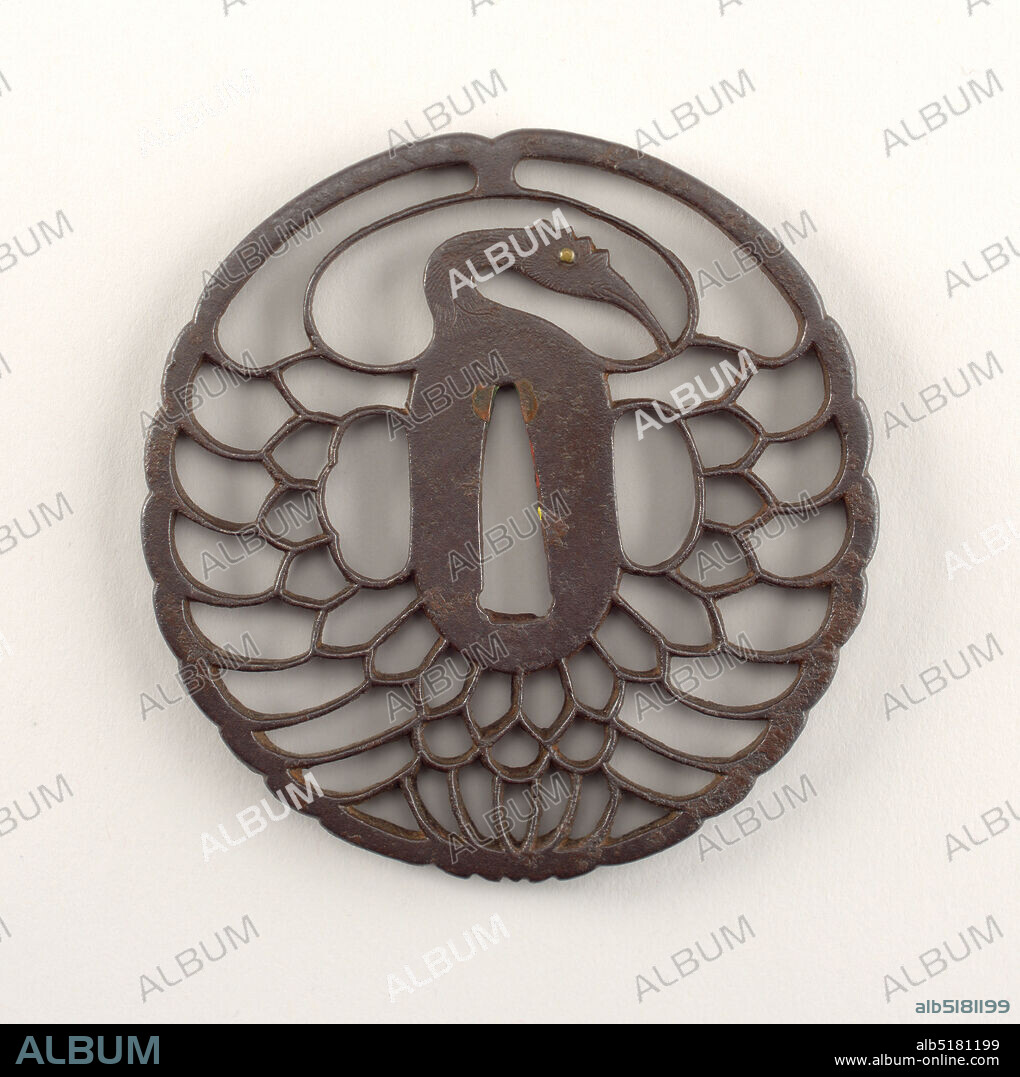alb5181199
Chrysanthemum crane, Iron, shakudo (a soft copper and gold alloy), This Kyo-sukashi (Kyoto openwork) style tsuba takes the form of a tsuru maru (crane circle). At the center is the nakago-ana, an opening through which the sword passes, with traces of sekigane (plugs added to fit the tsuba to a sword) made of shakudo (a soft copper and gold alloy). The surrounding seppadai (flat oval area) forms the body of the crane; it is elegantly long and narrow, with a migaki (burnished) surface. The head of the crane has kebori (line carving). Flanking the body are ryo-hitsu, openings for the kozuka (utility knife) and the kogai (skewer tool). At right is sashi ura, the side which faces the blade, whose opening takes the hangetsu-kei (half moon) shape. Opposite is sashi omote, the side which faces the sword hilt; its tri-lobed opening is of the suhama type, and symbolically represents the coastline of Horai, the holy island of the Immortals. The surrounding openwork forms symmetrical feathers with a sense of movement., Japan, 17th century, knotted, knitted and crocheted textiles, Decorative Arts, Tsuba, Tsuba.

|
Ajouter à une autre Lightbox |
|
Ajouter à une autre Lightbox |



Avez-vous déjà un compte? S'identifier
Vous n'avez pas de compte ? S'inscrire
Acheter cette image

Légende:
Voir la traduction automatique
Chrysanthemum crane, Iron, shakudo (a soft copper and gold alloy), This Kyo-sukashi (Kyoto openwork) style tsuba takes the form of a tsuru maru (crane circle). At the center is the nakago-ana, an opening through which the sword passes, with traces of sekigane (plugs added to fit the tsuba to a sword) made of shakudo (a soft copper and gold alloy). The surrounding seppadai (flat oval area) forms the body of the crane; it is elegantly long and narrow, with a migaki (burnished) surface. The head of the crane has kebori (line carving). Flanking the body are ryo-hitsu, openings for the kozuka (utility knife) and the kogai (skewer tool). At right is sashi ura, the side which faces the blade, whose opening takes the hangetsu-kei (half moon) shape. Opposite is sashi omote, the side which faces the sword hilt; its tri-lobed opening is of the suhama type, and symbolically represents the coastline of Horai, the holy island of the Immortals. The surrounding openwork forms symmetrical feathers with a sense of movement., Japan, 17th century, knotted, knitted and crocheted textiles, Decorative Arts, Tsuba, Tsuba
Crédit:
Album / quintlox
Autorisations:
Modèle: Non - Propriété: Non
Questions sur les droits?
Questions sur les droits?
Taille de l'image:
5195 x 5216 px | 77.5 MB
Taille d'impression:
44.0 x 44.2 cm | 17.3 x 17.4 in (300 dpi)
Mots clés:
17E SIECLE • 17EME S • CADAVRE • CORPS CADAVRES • CORPS HUMAIN • CORPS • CÔTE • DEMI-LUNE • DÉPOUILLE • DIX-SEPTIÈME SIÈCLE • EPEE • FER • FORMÉ • FORMES • FORMULAIRE • LITTORAL • MARITIME • METAL FER • MORT CADAVRES • MOUVEMENT • POIGNEE D'EPEE • TETE (ANATOMIE) • TETE • TSUBA • XVIIE SIECLE
 Pinterest
Pinterest Twitter
Twitter Facebook
Facebook Copier le lien
Copier le lien Email
Email
